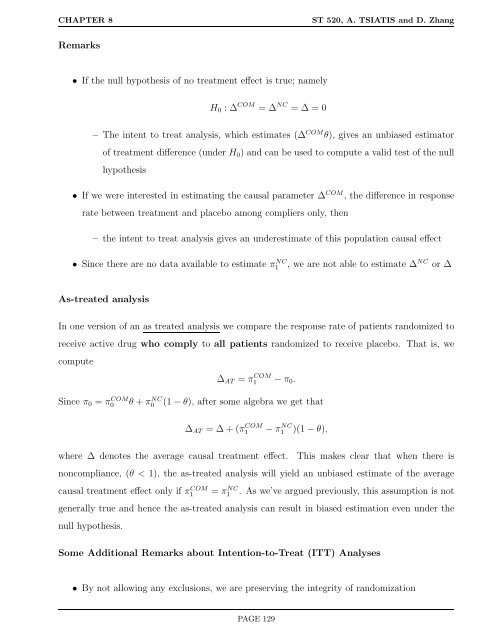ST 520 Statistical Principles of Clinical Trials - NCSU Statistics ...
ST 520 Statistical Principles of Clinical Trials - NCSU Statistics ...
ST 520 Statistical Principles of Clinical Trials - NCSU Statistics ...
Create successful ePaper yourself
Turn your PDF publications into a flip-book with our unique Google optimized e-Paper software.
CHAPTER 8 <strong>ST</strong> <strong>520</strong>, A. TSIATIS and D. Zhang<br />
Remarks<br />
• If the null hypothesis <strong>of</strong> no treatment effect is true; namely<br />
H0 : ∆ COM = ∆ NC = ∆ = 0<br />
– The intent to treat analysis, which estimates (∆ COM θ), gives an unbiased estimator<br />
<strong>of</strong> treatment difference (under H0) and can be used to compute a valid test <strong>of</strong> the null<br />
hypothesis<br />
• If we were interested in estimating the causal parameter ∆ COM , the difference in response<br />
rate between treatment and placebo among compliers only, then<br />
– the intent to treat analysis gives an underestimate <strong>of</strong> this population causal effect<br />
• Since there are no data available to estimate π NC<br />
1 , we are not able to estimate ∆ NC or ∆<br />
As-treated analysis<br />
In one version <strong>of</strong> an as treated analysis we compare the response rate <strong>of</strong> patients randomized to<br />
receive active drug who comply to all patients randomized to receive placebo. That is, we<br />
compute<br />
∆AT = π COM<br />
1<br />
− π0.<br />
Since π0 = πCOM 0 θ + πNC 0 (1 − θ), after some algebra we get that<br />
∆AT = ∆ + (π COM<br />
1<br />
− π NC<br />
1 )(1 − θ),<br />
where ∆ denotes the average causal treatment effect. This makes clear that when there is<br />
noncompliance, (θ < 1), the as-treated analysis will yield an unbiased estimate <strong>of</strong> the average<br />
causal treatment effect only if π COM<br />
1<br />
= π NC<br />
1 . As we’ve argued previously, this assumption is not<br />
generally true and hence the as-treated analysis can result in biased estimation even under the<br />
null hypothesis.<br />
Some Additional Remarks about Intention-to-Treat (ITT) Analyses<br />
• By not allowing any exclusions, we are preserving the integrity <strong>of</strong> randomization<br />
PAGE 129
















